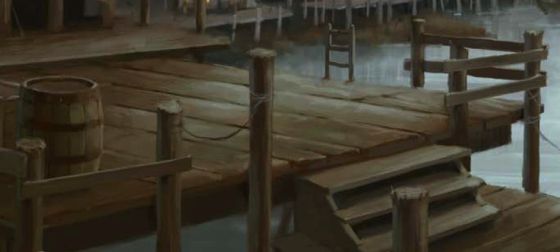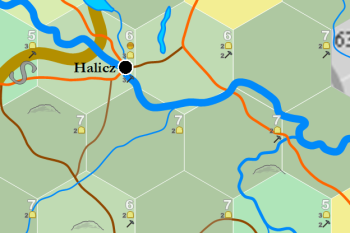Boat Dock
Boat docks are structures extending alongshore or out from a shore into a body of water, to which boats can be moored. As facilities, they occur as collections along the water adjacent to villages, towns and cities. They also occur single at points where a road or route reaches but does not pass over a semi-navigable or navigable river, or intersects with a lake. Boat docks only occur in hexes where a hammer symbol is present.
Boat docks are small in size, ranging from 6 to 12 ft. wide and 8 to 20 ft. long. When built on a river, they run parallel to the shore; upon a lake, they extend outward from the shore. Boat docks do not occur in water deeper than 12 ft. The primary benefit of a dock is for the loading and unloading of goods by service boats, which may or may not also carry passengers. Boat docks are not sufficiently secure or wide enough to load or unload ships greater than 5 tons in size, which require a quay. Depending upon the sort of route and hex type, docks may also enable passage across a river where a ferry does not exist.
River Ports
Although the main transfer of goods in towns and cities occur at quays or wharves, boat docks for individuals proliferate along the water's edge along both sides of a river or along a body of water. In towns and cities, freelance boathandlers operating lighters, prams, launches or dory are available to carry passengers across a river for a fee of 2 c.p. per trip, per point of river. Wait time is normally 2-16 minutes. Freight costs 5 c.p. per hundred lbs. Boats are available even if the river is bridged.
Villages have a single boathandler available to shuttle travellers across a river, and this is nearly always no more than a rowboat. Costs are the same, but wait time is extended to 3-30 minutes. Village boathandlers are more likely to deny passage to those whose character seems threatening or unseemly.
Interrupted Routes
The image shows an example of a cobblestone road (orange) that's interrupted by a water course, the Dnister River southeast of Halicz in Poland. The Dniester is "5 pts." wide at this point, as indicated by the size the river appears on the map. On one side of the interruption, we have a type-6 hex with 2 hammer symbols; on the other side, we have a type-7 with 1 hammer. Note that we can see an example further east where the same road passes over a 2 pt. tributary. This indicates a bridge.
Directly south of Halicz, we can also see a dirt road (dark brown) that's interrupted by a 1 pt. tributary. An instance like this doesn't indicate a boat dock, because a stream of 1 pt. isn't considered "semi-navigable." A stream of that size can be forded, though with some difficulty, as they offer many places along their course where the water is less than 3 ft. deep.
There are three matters to be determined regarding interrupted routes: the likelihood of finding a boat there; the type of boat being found there; and the willingness of that boat to take on passengers.

